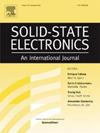A wideband symmetrical piezoelectric vibration sensor based on Gaussian electrode distribution with interface circuit
IF 1.4
4区 物理与天体物理
Q3 ENGINEERING, ELECTRICAL & ELECTRONIC
引用次数: 0
Abstract
This paper presents a new wideband symmetrical piezoelectric vibration sensor. The vibration sensor comprises a lead-free aluminum nitride (AlN) layer on a silicon substrate. The symmetrical sensor with Gaussian electrode distribution, a unique feature, has a wide frequency range and low transverse sensitivity. The measured −3 dB bandwidth of the vibration sensor ranges from 241 Hz to 339 Hz, approximately 98 Hz. The voltage sensitivity along the Z-axis is 733 mV/g with a linearity of R2 = 1. The maximum generated power is 26.4 nW at an optimal load resistance, which indicates the potential to extend the battery lifetime. Notably, the transverse sensitivity decreases from 3.75 mV/g to 3.16 mV/g, representing a reduction of about 16 % compared to a conventional sensor. The transverse sensitivity ratio of the symmetrical sensor is 0.43 % (Sx = 0.43 %), less than most previous designs. A charge amplifier amplifies the generated charge by the direct piezoelectric effect and converts it to an output voltage. An active low-pass filter eliminates unwanted signals. The interface circuit has a mid-band gain of 29 dB, a −3 dB bandwidth of about 270 Hz, ranging from 80 Hz to 350 Hz, and consumes only 128 nW. The interface circuit exhibits acceptable performance under different corners (SS, FF, SF, and FS) and varying temperatures (−50 °C to +50 °C). The vibration sensor with low cross-axis sensitivity can be used for high-precision measurements, and the ultra-low-power interface circuit can resolve charging requirements.
基于高斯电极分布和接口电路的宽带对称压电振动传感器
提出了一种新型宽带对称压电振动传感器。振动传感器包括硅衬底上的无铅氮化铝(AlN)层。采用高斯电极分布的对称传感器具有频率范围宽、横向灵敏度低的特点。振动传感器测量到的−3db带宽范围为241hz ~ 339hz,约为98hz。沿z轴的电压灵敏度为733 mV/g,线性度R2 = 1。在最佳负载电阻下,最大发电量为26.4 nW,这表明有可能延长电池寿命。值得注意的是,横向灵敏度从3.75 mV/g降低到3.16 mV/g,与传统传感器相比降低了约16%。对称式传感器的横向灵敏度比为0.43% (Sx = 0.43%),低于以往大多数设计。电荷放大器通过直接压电效应放大产生的电荷,并将其转换为输出电压。有源低通滤波器消除不需要的信号。该接口电路的中频增益为29db,−3db带宽约为270hz,范围为80hz ~ 350hz,功耗仅为128nw。该接口电路在不同角(SS、FF、SF和FS)和不同温度(−50°C至+50°C)下表现出可接受的性能。低交叉轴灵敏度的振动传感器可用于高精度测量,超低功耗接口电路可解决充电要求。
本文章由计算机程序翻译,如有差异,请以英文原文为准。
求助全文
约1分钟内获得全文
求助全文
来源期刊

Solid-state Electronics
物理-工程:电子与电气
CiteScore
3.00
自引率
5.90%
发文量
212
审稿时长
3 months
期刊介绍:
It is the aim of this journal to bring together in one publication outstanding papers reporting new and original work in the following areas: (1) applications of solid-state physics and technology to electronics and optoelectronics, including theory and device design; (2) optical, electrical, morphological characterization techniques and parameter extraction of devices; (3) fabrication of semiconductor devices, and also device-related materials growth, measurement and evaluation; (4) the physics and modeling of submicron and nanoscale microelectronic and optoelectronic devices, including processing, measurement, and performance evaluation; (5) applications of numerical methods to the modeling and simulation of solid-state devices and processes; and (6) nanoscale electronic and optoelectronic devices, photovoltaics, sensors, and MEMS based on semiconductor and alternative electronic materials; (7) synthesis and electrooptical properties of materials for novel devices.
 求助内容:
求助内容: 应助结果提醒方式:
应助结果提醒方式:


